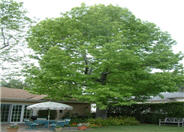
Common name:Winnifred Gilman Dark Blue Sage
Botanical name:Salvia clevelandii 'Winnifred Gilman'
The ' Winifred Gillman' Sage is a dense, compact sub-shrub that grows to 4'-5' tall and wide, and has a round form. It has blue flowers in spikes above the foliage in the spring and summer. This sub-shrub is native to California and is drought tolerant. -Cornflower Farms

Common name:Liquidambar, American Sweet Gum
Botanical name:Liquidambar styraciflua
A tall, deciduous tree of upright, pyramidal habit, the liquidamber has dark green, maple-like leaves that turn beautiful shades of red and yellow in the fall season. It can be used as a single specimen, hedge, or grouped plant.

Common name:Blue Bush Sage
Botanical name:Salvia 'Allen Chickering'
The Allen Chickering Sage is a perennial shrub that grows 2'-5' high and 2'-4' wide. It has blue flowers that bloom in the spring and summer. This shrub is native to California and is drought tolerant.
-Cornflower Farms

Common name:Deodar Cedar, Calif. Christmas Tree
Botanical name:Cedrus deodara
This fast-growing, coniferous evergreen is capable of reaching a size of 80' high by 40' wide. Its needles are a light, silvery green color.

Common name:Tree Aloe
Botanical name:Aloe arborescens
This succulent is large, full of branches and produces deep red orange blooms in fall and winter. The flowers produce a nectar that is attractive to many different birds; this plant is grown all over the world. This succulent can reach 8' tall and 5' wide. Leaves are narrow, recurved and tooth margined and can be green or yellowish or blue green, depending on how much sun it receives. It tolerates sun or shade.
| Designer: | Rustic Brick Wall |
Photographer: GardenSoft |
Soils and Compost:
Practice grass-cycling by leaving short grass clippings on lawns after mowing, so that nutrients and organic matter are returned to the soil.
Water Saving Tip:
Replace turf with groundcovers, trees, and shrubs. If you have areas where no one uses the grass, patches that do not grow well, or a turf area too small to water without runoff, consider replacing the turf with water-efficient landscaping.
Integrated Pest Management:
Drip and other smart irrigation delivers water directly to roots, allowing no excess water for weeds.
